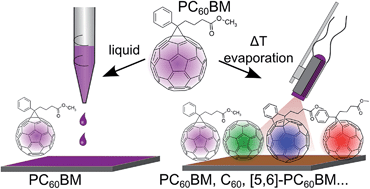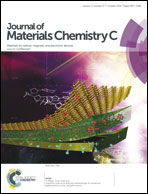Impact of processing on the chemical and electronic properties of phenyl-C61-butyric acid methyl ester†
Abstract
For the comparison of solution-processed to evaporated materials in organic optoelectronic devices, phenyl-C61-butyric acid methyl ester (PCBM) has been claimed to be a suitable material. However, we ascertained differences between spin-coated and vacuum sublimed thin films. In this contribution, we thoroughly investigate the effects of thermal evaporation of PCBM in a strongly interdisciplinary approach, applying physical characterization techniques such as photoelectron (PES) and infrared (IR) spectroscopy in combination with further chemical analysis using thermal gravimetric analysis (TGA), differential scanning calorimetry (DSC) and ultra-performance liquid chromatography-coupled mass spectrometry (UPLC-MS), as well as proton nuclear magnetic resonance spectroscopy (1H-NMR). The methods were applied to thin films prepared by solution-based deposition techniques and by thermal evaporation. Additionally, comparison to an evaporated C60 film and the crucible residues is carried out. Changes in the IR spectrum of the PCBM films already indicate a change in the molecular structure of PCBM. The UPLC chromatogram of the redissolved organic film proves the formation of several molecular species, including bare C60. However, the effect of degradation on the electronic properties was found to be limited, as an almost unchanged ionization potential of 6.1 eV was determined with UPS for both the solution processed as well as the evaporated films. Also bulk-heterojunction (BHJ) solar cells fabricated using pure and thermally treated PCBM showed the same J–V characteristics under illumination.


 Please wait while we load your content...
Please wait while we load your content...